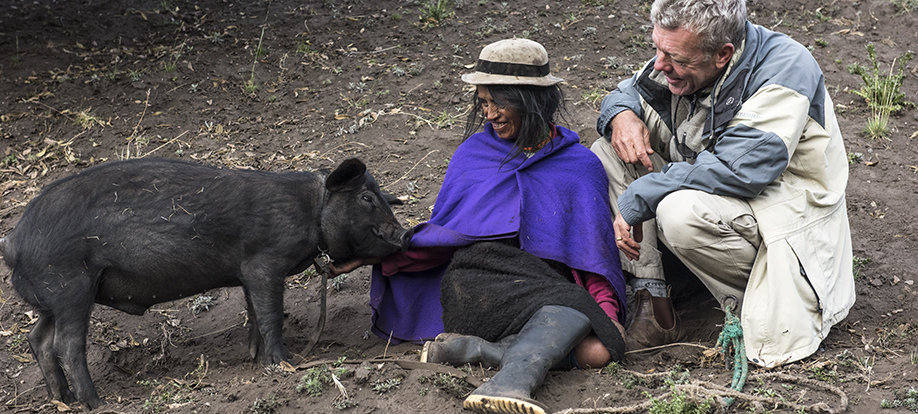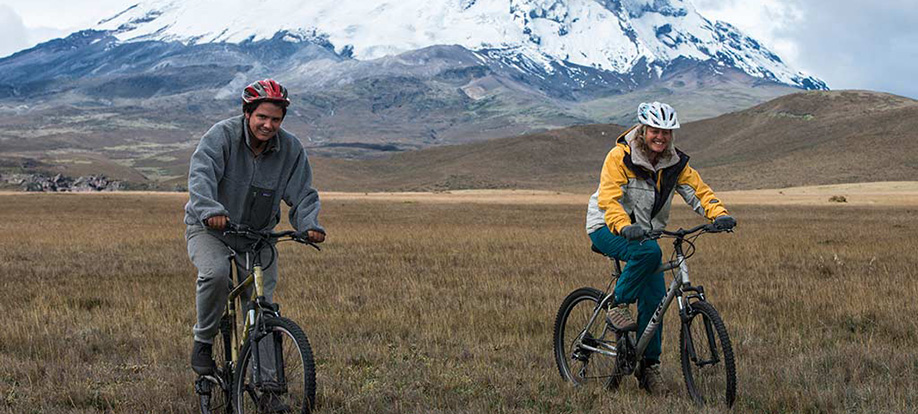We recently had family visit from the UK. Starting with the amazing churches of downtown Quito, said to be the best-preserved colonial center in the whole of South America. Even for non-religious folks the ostentatious splendor of a multitude of Spanish churches and cathedrals, dripping with Inca gold and Catholic artifacts is always a sensory overload coupled with a deep sense of history and subjugation.
The aim, in part, was to open the eyes of young Katie to a different world where travel and immersion in new cultures goes a long way in educating intelligent young minds – or as Mark Twain once said: Travel is fatal to prejudice, bigotry and narrow-mindedness …

Day two and our sojourn began in earnest. We headed south to one of Ecuador’s highest snow-capped peaks, Cotopaxi (the world’s highest active volcano). With a jeep full of mountain bikes we then headed down the impressive slope of the volcano, from 4560 meters, to the flatter paramo below. A classic cone, Cotopaxi rarely disappoints. Our destination for overnight was to be on the high slopes of Chimborazo Volcano, the peak of which is the farthest point from the center of the planet (due to the bulge in the earth).

On our previous visit, at Christmas with friend from New York, we had stopped at Calpi animal market. With no stalls for the livestock and little or no discernable order we pushed hordes of tethered cattle out of our path to make headway through the throng. The local Indians, dressed in ponchos, felt hats and sandals, joked with us, offering the best price if we would just buy one of their cows. Then we arrived at the pigs. Ten or so piglets per merchant radiated on taught ropes like spokes of a wheel from the stakes in the ground. In a squealing cachophany they were doing what pigs do – all but one – a little chap with a particularly squashed looking face. After some haggling Owen and Ana bought him. Stopping for a few snacks, declining the roasted chicken feet, we bought some fruit, including a few things that the piglet might enjoy. He quickly settled in, as any other passenger might and was quite at home as we continued in the minibus towards Chimborazo. Our quarters were simple and set within a small indigenous community of pastoralists who mostly tended a herd of alpacas. Rosa was our host, a lovely woman whom Renee and I had come to know fairly well over fifteen years of visits. She owned a cow, five sheep, several dogs and now, after a somewhat sad exchange, she owned a pig too. A promise was made that the pig, now named in my honour as Peter, would enjoy a long and happy life and the business of building him a nice place to live was attended to. Many of the human dwellings meanwhile were merely tiny sod huts with a thatched roof, low doorway and a fire set in the middle of the floor, for warmth, cooking and boiling water. The entire insides were blackened with soot.
Arriving back to see Rosa I cautiously asked how was Peter the Pig. “Petercito is wonderful”, she said “And so friendly!”. We were delighted and as soon as we saw him, how he had grown and Rosa’s relationship with him we could not have been more pleased. The following morning Petercito was standing up and leaning over his door. He is keen to go to work she told me. “What work?” I said. He has to go out fertilizing and turning the soil she told me!
We left with a vision of a happy pig in our minds as we followed Rosa, with the communal herd of alpacas in her charge as she led them to the slopes of Chimborazo to spend the day grazing.
Back on our mountain bikes we finished the first part of our tour by riding 35km, all downhill, on a beautiful country back road to Ambato.
You too could join Pete and Renee on a tailor-made trip to Ecuador. Having lived in Ecuador for more than 3 decades they certainly know their way around.
All images ©PeteOxford.




 Until next time, keep exploring!
Until next time, keep exploring!